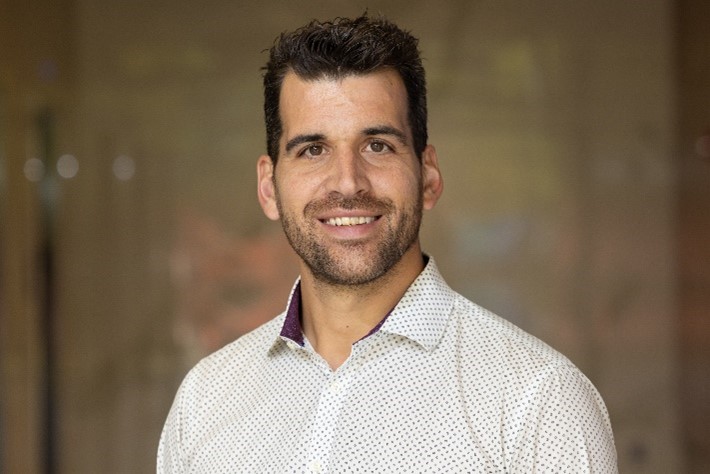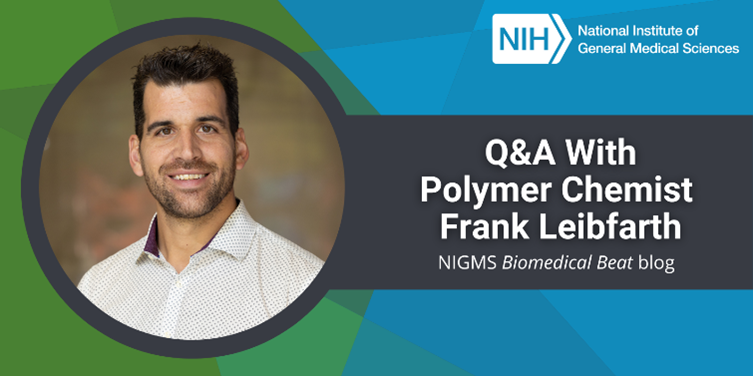
“I love that you can change the molecular-level structure of a material, then pull it, bend it, or twist it and see firsthand how the molecular changes you introduced influence its stretchiness or bendiness,” says Frank Leibfarth Ph.D., an associate professor of chemistry at the University of North Carolina (UNC) at Chapel Hill. In an interview, Dr. Leibfarth shares with us his scientific journey, his use of chemistry to tackle challenges in human health and sustainability, and his beliefs on what makes a career in science exciting.
Q: What led you to study chemistry?
A: Being a first-generation college student from a small town in South Dakota, I didn’t really have much guidance in navigating the college process. I went without a plan, but I knew that I generally liked science and math. In my first-semester organic chemistry class, a light bulb went off. Until then, when I would push biology professors for more information about why or how the interaction between a molecule and a receptor would cause change in a cell, they couldn’t answer! Organic chemistry class was the first time I got concrete answers to those types of questions that I’d always naturally had.
During that time, I was also inspired by the idea that researchers could actually study those interactions to learn what happens and not have to rely on cartoon models. That class was a launching point to a career in science for me.
Q: What was your path to becoming a scientist?
A: I attended the University of South Dakota for undergrad, where I double-majored in chemistry and physics. There, I had mentors whom I developed great relationships with. They nudged me in the direction of continuing in science and taught me valuable skills that I would need in that process, including how to write the best graduate school application and how to tell my story on paper.
I was fortunate to participate in two research experiences for undergraduates through the National Science Foundation. The first summer, I worked at Columbia University on an organic synthesis project, and the second summer, I worked at IBM Research – Almaden with Dr. James Hedrick through a program with Stanford University, where I learned how to apply techniques in chemical synthesis to polymers, which is the field I still work in today.

I then earned a Ph.D. in chemistry from the University of California, Santa Barbara, working on polymer synthesis with Dr. Craig Hawker, who has been an incredibly important mentor to me and someone I still look up to. I wanted to learn more about fundamental organic chemistry during my postdoctoral research because I felt that would round out my training and prepare me for my independent career. I went to work with Dr. Timothy Jamison at the Massachusetts Institute of Technology on a project developing new and sophisticated ways to build molecules. In 2016, I moved to UNC to start my own lab.
Q: What does your lab study?
A: My lab’s main research question is: How can we change the molecular structure of materials such as plastics to give them more desirable properties? We use various ways to substitute the chemical bonds between carbon and hydrogen atoms in a polymer to ultimately build new materials. We then see if the properties of the new material make it well suited to applications in human health or sustainability.
This research idea was inspired by work in medicinal chemistry, where chemists substituted similar carbon-hydrogen bonds in medicines to give them more desirable properties. The lessons that chemists learned from that work allowed us to apply the technique to much bigger molecules—polymers and plastics.
Q: What are the human health applications of your research?
A: Materials that dissolve or degrade safely in the body are used in a wide range of medical devices, such as implants that release medicines over time or temporary stitches. Despite there being so many different types of degradable medical devices, they’re made of only a handful of polymers. We take those polymer building blocks that are already known to be safe and effective, and we slightly modify their chemical structures to create new building blocks with new properties. For instance, we can increase or decrease the speed that stitches degrade in the body or adjust the dose of medicine that an implant will release by changing how easily the drug can escape the device. By doing this, we’re not only adding to the list of building blocks that can be used in medical devices but also creating the opportunity to tailor these devices to patients’ specific needs.
Q: What are the sustainability applications of your research?
A: In the sustainability space, we’re interested in finding better ways to deal with plastic waste. Millions of metric tons of plastic waste are generated every year—much of that being single-use items like milk jugs or plastic grocery bags. We’re interested in how best to upcycle single-use plastics after they’re disposed of by introducing a small number of changes to their polymers to create a material of higher value.

In the past, we’ve taken a material often used in plastic food packaging, and through this process, made a super-resilient and impact-resistant material that can be used in golf balls. Upcycling allows us to keep the carbon originally taken from the earth as petroleum in circulation longer by giving it new life. Also, we hope that upcycling will create an economic incentive for towns and cities to improve their plastic collection and sorting, given that the plastics can be remade into higher-value items.
Q: What are some goals you hope to achieve in your career or your research?
A: My primary goal in my career is to educate the next generation of scientists. I hope to give my students the tools they need to succeed and make a positive difference in the world with science, whether it’s in academia or industry, through their writing or science policy work, or through any of the many other fields my students are interested in. I also hope to continue to demonstrate that doing clever chemistry on polymers can make a meaningful difference in human health and sustainability.
Q: In your opinion, what makes a career in science exciting?
A: The fact that the work is never finished. When you make a big discovery, it just opens new doors. Because of that, you have to be comfortable with always having more to do because the story is always evolving.
Dr. Leibfarth’s research is supported by the NIGMS Maximizing Investigators’ Research Award program through grant R35GM142666.


